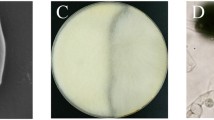Abstract
One hundred and ninety-eight isolates of Microsporum canis, obtained from humans and animals in 12 countries, were paired with the two Japanese tester strains of Nannizzia otae (= M. canis), VUT 74037 (CDC B-2094+) and VUT 74039 (CDC B-2095−). One hundred and forty-one (72%) produced either gymnothecia or pseudogymnothecia in crosses with VUT 74037. Fifty-seven (28%) were nonreactive. None of the paired isolates reacted with VUT 74039. The number of nonreactive isolates decreased to 17% when 104 of the 198 isolates were paired with one additional tester strain of each mating type. All sexually reacting strains, however, belonged to the (−) mating type. Crosses between nonreactive isolates did not result in ascocarp formation.
The F1 generations from three different strongly reactive crosses were all characterized by poor ascospore germination. Most of the monoascospore progeny that germinated to form mature colonies were nonreactive in crosses to determine their mating type. Others reacted predominantly as the (+) mating type, thereby precluding the likelihood of an associated lethal factor accounting for the lack of this mating type in our clinical isolates. Several explanations for this phenomenon are presented.
Similar content being viewed by others
References
Ajello, L. Shu-Lan Y. Cheng. 1967. The perfect state of Trichophyton mentagrophytes. Sabouraudia 5: 230–234.
Gallegly, M. E. & J. A. Galindo. 1958. Mating types and oospores of Phytophthora infestans in Mexico. Phytopath. 48: 274–277.
Hasegawa, A. & K. Usui. 1974. The perfect state of Microsporum canis. Jap. J. Vet. Sci. 36: 441–449.
Hasegawa, A. & K. Usui. 1975. Nannizzia otae sp. nov., the perfect state of Microsporum canis Bodin. Japan. J. Med. Mycol. 16: 148–153.
Kwon-Chung, K. J. 1971. Genetic analysis of the incompatibility system of Ajellomyces dermatitidis. Sabouraudia 9: 231–238.
Padhye, A. A., A. S. Sekhon, & J. W. Carmichael. 1973. Ascocarp production by Arthroderma and Nannizzia species on keratinous and non-keratinous media. Sabouraudia 11: 109–114.
Stockdale, Phyllis M. 1963. The Microsporum gypseum complex (Nannizzia incurvata Stockd., N. gypsea (Nann.) comb. nov., N. fulva sp. nov.) Sabouraudia 3: 114–126.
Takashio, M. 1973. Une nouvelle forme sexuee du complexe Trichophyton mentagrophytes, Arthroderma vanbreuseghemii sp. nov. Ann. Parasit. hum. et comp. 48: 713–732.
Weitzman, Irene. 1964. Variation in Microsporum gypseum. I. A genetic study of pleomorphism. Sabouraudia 3: 195–204.
Weitzman, Irene & Margarita Silva-Hutner. 1969. Nonkeratinous agar media as substrates for the ascigerous state in certain members of the Gymnoascaceae pathogenic for man and animals. Sabouraudia 5: 335–340.
Author information
Authors and Affiliations
Rights and permissions
About this article
Cite this article
Weitzman, I., Padhye, A.A. Mating behaviour of Nannizzia otae (=Microsporum canis). Mycopathologia 64, 17–22 (1978). https://doi.org/10.1007/BF00443083
Issue Date:
DOI: https://doi.org/10.1007/BF00443083




